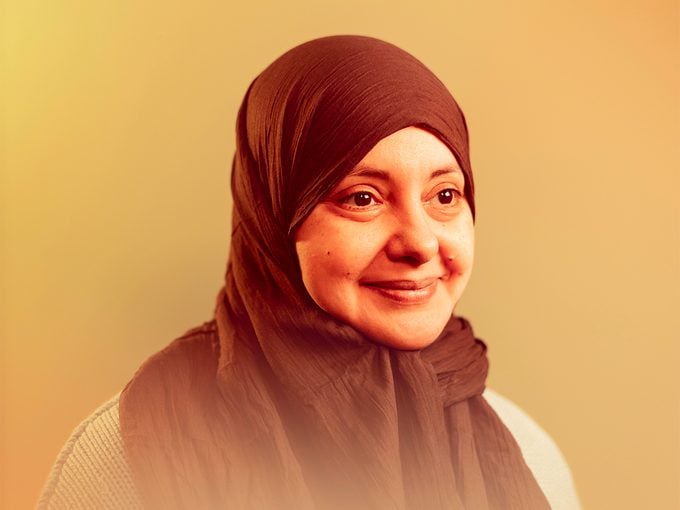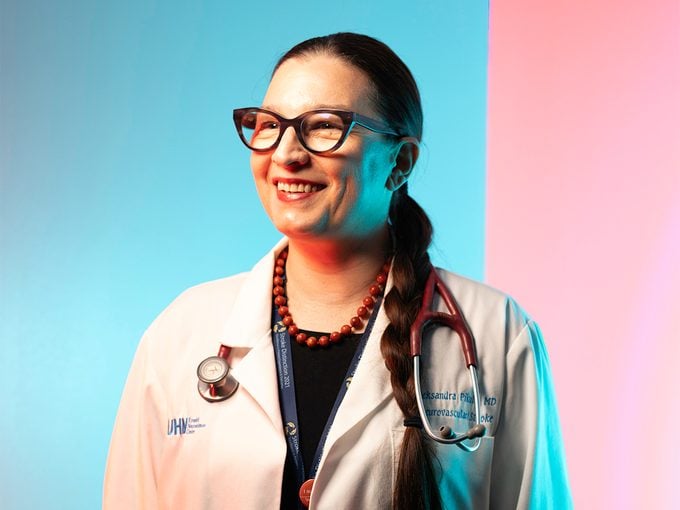16 Reasons to Feel Good About The Future of Women’s Health
There’s a whole lot more MNRA can do
Messenger RNA, or mRNA, are like microscopic blueprints for the body. They show our cells how to assemble an important proteinlike, for example, COVIDs infamous spikeso our body recognizes that protein as something foreign and dangerous, and mounts an immune response. mRNA vaccines are safe, effective and lightning-fast to produce: As long as we know the protein to encode, we can do it in the lab in about two weeks, says Anna Blakney, an assistant professor at the School of Biomedical Engineering and the Michael Smith Laboratories at UBC. Now that we have these mRNA vaccines for COVID, were thinking about where to go next.The mRNA platform has massive potential for cancer treatment. Cancer is a far more complex disease than COVID; theres no single target, like the spike, to protect the whole population against. But the speed and precision of mRNA sequencing opens up the possibility of personalized medicine: You take a biopsy from a patients tumour, see what proteins are specific to that tumour and design a purpose-built vaccine. Thats huge, because it means we may not have to use chemotherapy and drugs that are very non-specific and have really high side effects, Blakney says.In her lab, Blakney and her team are working on a vaccine for chlamydia, a disease that can cause pelvic inflammatory disorder and lead to infertility in women. We really need a vaccine to prevent it, similar to the HPV vaccine, she says. Their ovarian cancer project is trying to encode an antibody called a bispecific T-cell engageror BiTEthat helps T cells kill cancer cells. And their work with Torontos Sunnybrook Hospital will see if RNA can reprogram cells into neurons to change the progression of neurodegenerative disorders like Alzheimers. This was not something I was thinking about even five years ago, Blakney says. The breadth of the applications is whats so exciting.
Your pelvic floor deserves a custom fit
and thats very much not the case for women who may experience prolapse (up to 50 percent of us!). Right now, treatment comes down to surgery or an off-the-shelf pessary, but Toronto-based Cosm uses AI and 3D printing for a personalized pessary, a big improvement on a design that has not budged in 50 years.

Stem cells could give us back our sight
The eye is a finicky organ, and once our retinal cells are damaged from diseases like glaucoma, those cells are gone for good. At UHN’s Donald K. Johnson Eye Institute, postdoctoral researcher Tahani Baakdhah takes pluripotent stem cellswhich can be nudged to form any sort of cell in the bodyand encourages them to transform into retinal ganglion cells, the neurons that connect our eyes to our brains. Were moving toward transplanting these cells into animal models and seeing if they can make that connection, Baakdhah says. The work isnt easy; its going to take some time. But Im having good vibes about this, she says. Im optimistic I will help people see this beautiful, colourful world.
Bioprinted mini brains will map dementia
For decades, scientists have been on the lookout for effective treatments for neurodegenerative disease, to no avail. So researchers at the University of British Columbia decided to take matters into their own hands, combining stem cells from the blood of Alzheimers patients with a state-of-the-art 3D bioprinter in order to grow pint-sized tissue models of the patients very own brains. With these mini models, researchers are able to study the diseases progression, see how the brain tissue reacts to treatments and, ultimately, discover new drugs that could slow or even halt the march of dementia.
We’re finally collecting better data…
Until just a few years ago, we knew way more about the rat brain than the female human brain. Its a very humbling starting point, says Esther Bui, a neurologist and epilepsy specialist at UHNs Krembil Brain Institute. Theres so much work to be done.Before 2021when it became required, where appropriate, to include sex and gender in research projects80 percent of human neuroscience research did not consider sex as a biological variable. Bui breaks it down: Women were systematically excluded from clinical trials because it was too complicated to track periods, or it was too worrisome to include women who may become pregnant. And yet its not too complicated to map out the whole genome sequence? We should all feel so incredulous. Womens symptoms of diseases, common or life threatening, are often called atypical but atypical only because most diseases have been heavily studied in men. It means women have a higher chance of being misdiagnosed or dismissed by their healthcare provider.Happily, Bui says this is a supernova time for womens neurology, where research and education arefinally catching upin 2019, she developed Canadas first accredited Womens Neurology Fellowship trainingand we can better define precision medicine for women. Everyone tells me what Im not doing is not visionary work, Bui says. But visionary work is not just looking forward. Its also looking back to make sure no one is left behind.
… And that data will be inclusive
Janet Tootoosis is trying to understand what health progress looks like from an Indigenous perspective. As the vice dean of the Division of Indigenous Health at the University of Saskatchewans College of Medicine, she is committed to a strength-based approach, which empowers both patients and practitioners by moving the focus away from health deficits and toward Indigenous peoples capacities and capabilities. The new departmentthe first of its kind in Canadaaims to integrate Indigenous teachings with western medicine, give physicians opportunities to enhance their skills in Indigenous health and provide Indigenous med students the option of having specialized credentials. Tootoosis insists that the people whove been failed by our current health-care systemand by academiamust form the inner workings of the new department. And shell measure success by the impact she makes at the community level. I want Indigenous people to say: I like what youre doing at the College of Medicine.
The smallest molecules will have a big impact on diagnosis
Over the course of our lifetimes, were exposed to all manner of tiny molecules. Some of them come from our world, in foods or shampoo. Some of them are in our bodies, like sugars and fats. Together, they give researchers a picture of how our genes interact with the environment, especially when it comes to what might trigger disease.Thats handy, because many diseases rely on clinical diagnosis, which determines a disorder based on a patients symptoms. But something like pain is quite subjective, says Nikita Looby, PhD, a scientific associate at UHNs Schroeder Arthritis Institute. The goal of metabolomicsthe study of these molecules, called metabolitesis to move to objective measures in order to diagnose diseases, monitor their progression and evaluate the response to treatment.Loobys work focuses on psoriatic arthritis, which can lead to irreversible damage and disability. There are so many ways in which this disease can manifest that make it difficult to nail down, Looby says. It drives me insane, to be honest. She wants to take all those patient symptoms and correlate them with the presence and concentration of different metabolites. Then we can run a rapid test on someones blood sample and, based on the metabolites, know what the diagnosis is and figure out the treatment.But metabolomics could allow researchers to be proactive, as well. When we know what molecular markers are associated with arthritisor any sort of diseasewe can develop drugs to intervene before the damage is done. The entire idea behind metabolomics, Looby says, is that one size doesnt fit all, and one drug doesnt solve all.
There’s new hope for preemies
Incubators can only do so much. At Torontos SickKids hospital, researchers are investigating artificial placentas that could deliver essential oxygen and nutrients to preemies and let doctors more safely perform life-saving surgeries.
We can wrangle syphilis back into submission
Syphilis rates have skyrocketed in recent years, especially among women of child-bearing age: Between 2016 and 2020, cases went up a whopping 775 percent, according to the Public Health Agency of Canada. But diagnosis and treatment can be a challengepeople might be reluctant to access health care services, or they dont return once their blood has been taken. Thats why University of Alberta infectious disease expert Ameeta Singh helped research a rapid test that identifies syphilis and HIV in a flash, so people can be tested and treated in a single visit. It also works really well in a variety of settings, whether thats on the street, in a van or in community health centres, she says.
Breast milk will help everyonenot just newborns
Breast milk has major benefits for immunocompromised folks, so biotech company Lactiga is making it into medicine. Taken via pills or an inhaler, it givesimmunocompromised people a boost in their fight against COVID, mucosal diseases and gastrointestinal infections.
Drones will drop medicine where you need it
Rural, remote and Indigenous communities often struggle to provide health care to the people who need itmedical supplies take too long to get there, if they can get there at all. When resources cant get to patients, patients have to be brought to resources, which costs precious time. So family doctor John Pawlovich is working with the University of British Columbia to see how drones can help out. Over the course of a year, one small drone, packing prescriptions and other medicines, carried out 1,200 flights in all conditions between Stellaten First Nation and the Village of Fraser Lake. Next up: testing bigger drones that can travel longer distances (and even up over mountains) to make remote health care more accessibleand more equitable.

A trusty home blood-pressure monitor adds years to our lives
Lets start with some uncomfortable facts. More than 108,000 Canadians experience a stroke each year, a statistic that has nearly doubled over the past two decades. Stroke kills twice as many women annually as breast cancer, and among people under 55, rates are on the rise, due in part to lifestyle-related risk factors like sedentary behaviour, substance use and stress. Still, studies show that 70 percent of women dont know about any of the stroke risk factors. Its a statistic that worries neurologist Aleksandra Pikula, research director of UHNs Stroke Program, and one shes hoping to change in her capacity as the inaugural Jay and Sari Sonshine Chair in Stroke Prevention and Cerebrovascular Brain Health at UHNs Krembil Brain Institute.The biggest culprit for stroke is high blood pressure, which often ticks up during perimenopause. I have a truly powerful message for all women approaching midlife, Pikula says. Know your numbers. Normal blood pressure is below 120 over 80. Anything higher and you should be checked by your primary care providerand you must start working on lifestyle changes. With just a five-point decrease in blood pressure, our risk of stroke can drop by up to 20 percent, so start small: Cut back a little on salt or ultraprocessed foods. Maybe walk 10 or 15 minutes a day. Eighty to 90 percent of strokes are linked to modifiable risk factors, says Pikula, and when she says modifiable, she means we can work on them.High blood pressure is a silent killer. It doesnt hurt and there are no symptoms until it is severely high, but it can wreak havoc on your cardiovascular and brain health. A home blood pressure monitor is a basic tool that delivers vital information, and any adjustments you make to your lifestylein terms of nutrition, physical activity, sleep, stress, social connections and substance usewill pay big dividends in your overall health. As Pikula points out, what works for the prevention of diabetes works for the prevention of cardiovascular conditions works for prevention of stroke.
A breath test could detect lung cancer
The deadliest form of cancer, with rates that are only going up in non-smoking women. At the BC Cancer Research Institutes Breathomics Lab, researchers catalogue thousands of biomarkers in hundreds of breath samples to build a non-invasive breathalyzer test that can catch lung cancer early.
We’re trying to get to the bottom of pain
The medical community is fuzzy on pain. It can be hard to establish severity everyones five on a pain scale is differentand in the absence of an objective test to determine treatment, discrimination creeps in. Although roughly half of all chronic pain conditions are more common for women, doctors are more likely to dismiss their pain. Heres just one example: Middle aged women with symptoms for heart disease (like chest pain) are twice as likely to be told the cause is mental illness than men with the same symptoms, whose conditions are taken more seriously. Mojgan Hodaie, a neurosurgeon at Toronto Western Hospital, is on a quest to better understand where in the brain pain comes from, what consequences it has, and how to make sure its given its due. Doctors have all sorts of unconscious biases, Hodaie says. How can we take pain from being a purely subjective phenomenon to one with a greater objective understanding?By coupling machine learning with brain images, her team created a brainage calculator that looks at the gap between how old a persons brain appears and their actual age. Women, they found, are most at risk for accelerated brain aging across more types of chronic pain. Why does this happen? Thats also what Hodaie is trying to find out, in order to unlock more targeted treatmentsones that really consider the snowball effects of chronic pain, rather than just bandage over them.

We can make a better blood vessel
When you get sick, or are diagnosed with a chronic condition, its often because cells in your body arent performing as they should. To restore function, doctors can transplant new cells to compensate for failing onesbut the trick is getting those cells to survive once theyre in your body. New cells die for all sorts of reasons, but a main one is the lack of blood vessels bringing life-sustaining oxygen and nutrients to the transplanted cell. Sara Vasconcelos, a researcher at UHNs Toronto General Hospital Research Institute and the John Kitson McIvor Endowed Chair in Diabetes Research, thinks artificial blood vessels could be the solution. By growing those vessels in a lab, doctors will be able to transplant them together with the new cells to ensure better compatibility.Right now, Vasconcelos and her team are working on a few approaches. One involves a form of what Vasconcelos calls recycling blood vessels, taking those vessels from parts of the body that can spare them (like fat) and transplanting them into new cells. But sometimes, recycled vessels are also affected by diseases like diabetes, so Vasconcelos is making new small blood vessels from scratch using stem cells. The hope, says Vasconcelos, is to be able to replenish cells wherever theyre failing due to chronic conditions: This work could be applied to many places throughout the body.
More doctors will diagnose endometriosis on the spot
At least one in 10 women suffer from endometriosis, but theres plenty we dont know about this disease: what causes it, what could prevent it and what a cure might look like. Even diagnosis can be a bit of a crapshoot, based on a set of symptoms or through laparoscopy, a surgical procedure that might take years to get on the books. At McMaster University in Hamilton, Ont., gynecologic surgeon and sonologist Mathew Leonardi has uncovered a far more efficient approach. Trans-vaginal ultrasounds can identify endometriosisits right there in the imaging, if you know where to look. Hes now teaching that skill to practitioners, so more patients can access this minimally invasive diagnostic tool.Endometriosis is an invisible disease, he says, but an imaging test reveals what exactly is happening in our bodies. It gives us so much more information to guide patients to the right treatment strategies.
The post 16 Reasons to Feel Good About The Future of Women’s Health appeared first on Best Health.
